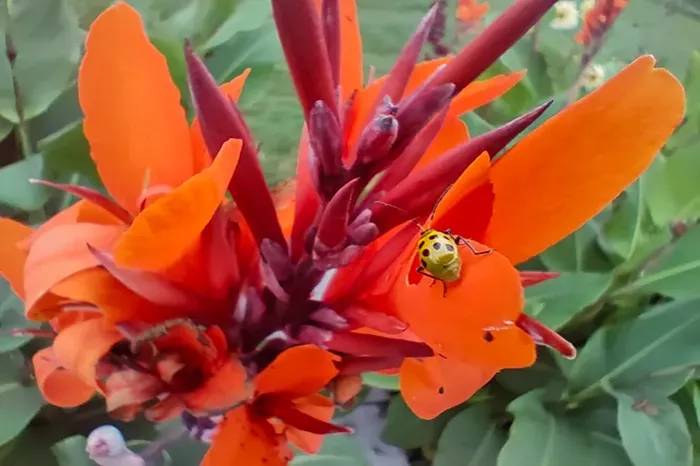Last week, we faced an unexpected problem in the garden: a significant outbreak of spotted cucumber beetles. Surprisingly, these pests were not in the vegetable garden where we typically expect to find them. Instead, they invaded the flower garden.
In Michigan, two types of cucumber beetles are common: the spotted cucumber beetle and the striped cucumber beetle, with the striped beetle being the more prevalent species. Both types prefer plants in the cucurbit family, which includes cucumbers, squash, and other vine crops.
The striped cucumber beetles survive the winter as adults in Michigan. This is why we see them early in the growing season. They feed on young cucumber seedlings and can quickly destroy a whole crop.
Cucumber plants produce a bitter compound as they grow. This compound accumulates in the bodies of the beetles when they feed. The bitterness makes the beetles less appealing to predators. This need for the compound drives the beetles to seek out cucurbits as soon as they detect them. Interestingly, male beetles transfer this compound to females during mating. The females then pass it on to their eggs, which will also contain high levels of the bitter substance, making them even less appetizing.
In our garden, okra flowers showed signs of damage from spotted cucumber beetles, which left holes in the petals. There were three beetles in the center of one flower. While both species prefer cucurbits, the spotted cucumber beetle will also feed on other plants if cucurbits are not available.
Unlike the striped beetle, the spotted cucumber beetle does not overwinter in Michigan. Instead, it migrates north from warmer southern states. These beetles overwinter south of the 37th parallel, near the Kentucky-Tennessee state line. When warm weather arrives, they migrate northward by flying or being carried by winds.
Unfortunately, the insect-repelling properties of marigold flowers could not stop the spotted cucumber beetles. The beetles crawled deep into the petals to feed. Both types of beetles are about a quarter of an inch long, with oval bodies. They have bright yellow coloring, with one type featuring three black stripes and the other having twelve black spots. They are attractive insects, but their feeding habits can cause significant damage.
Both the spotted cucumber beetle and Jerusalem artichokes are native to North America. Recently, the spotted cucumber beetles have taken over our flower garden.
Most of the cucurbit vines in our garden have died or are dying, leaving little food for the beetles. So, they turned to the flowers instead. Initially, they fed on the pollen of zinnias but soon switched to chewing the petals. Almost every type of flower in our garden had beetles feeding on them at the same time as bees and other pollinators. It created quite a busy scene.
Dahlias were the favorite flower of the cucumber beetles and suffered the most damage. Despite this, pollinators continued to collect nectar from the blossoms.
The beetles will keep feeding until the weather turns cold. They will seek out sheltered spots to overwinter. Most will not survive the winter, but a few may endure in warmer microclimates until spring.
Related topics:
- Chrysanthemums: The Flower of October
- How to Grow Plants While Reducing Disease Risks in NC
- Key Steps to Ensure Your Agapanthus Blooms Abundantly Next Year


